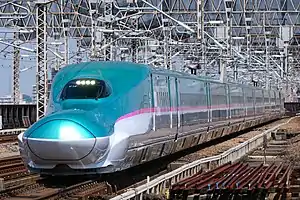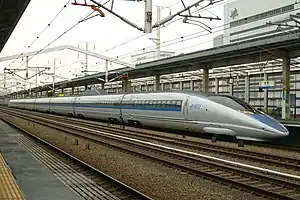 JR West 8-car 500 Series Shinkansen on a Kodama service at Himeji Station, August 2009 | |
| Overview | |
|---|---|
| Service type | Shinkansen |
| First service | 1958 (Limited express) 1 October 1964 (Shinkansen) |
| Current operator(s) | JR Central, JR West |
| Route | |
| Termini | Tokyo (Tōkaidō Shinkansen) Shin-Osaka (San'yō Shinkansen) Shin-Osaka (Tōkaidō Shinkansen) Hakata or Hakataminami (San'yō Shinkansen) |
| Stops | All-stop |
| Line(s) used | Tōkaidō Shinkansen San'yō Shinkansen |
| On-board services | |
| Class(es) | Green/standard |
| Catering facilities | None |
| Technical | |
| Rolling stock | 500/700/N700 series |
| Track gauge | 1,435 mm (4 ft 8+1⁄2 in) |
| Electrification | 25 kV AC overhead |
| Operating speed | 285 km/h (175 mph)[1] |
Kodama (こだま, "Echo") is one of the three train services running on the Tōkaidō and San'yō Shinkansen lines. Stopping at every station, the Kodama is the slowest Shinkansen service for trips between major cities such as Tokyo and Osaka. The Kodama trains are used primarily for travel to and from smaller cities such as Atami. Travelers between major cities generally take the Nozomi or Hikari services, which make fewer stops, although the former isn't covered under the Japan Rail Pass while the Kodama is,[2] making these services an affordable alternative.
Services
Kodama trains generally run over shorter distances than Nozomi and Hikari trains. Typical Kodama runs include Tokyo - Nagoya / Shin-Osaka, Tokyo - Mishima / Shizuoka / Hamamatsu, Mishima / Shizuoka / Nagoya - Shin-Osaka, and Shin-Osaka / Okayama / Hiroshima - Hakata as well as some shorter late-night runs.
The trainsets used for Kodama service are the same 700 series, and N700 series trains used for the Hikari and Nozomi services. Older 100 series and 300 series trains were also used for Kodama services on the Sanyō Shinkansen until they were withdrawn in 2012. In December 2008, reconfigured 500 series trains entered Kodama service to replace the withdrawn Sanyō Shinkansen 0 series trains. Many Sanyō Shinkansen Kodama services continue to and from Hakata-Minami on the Hakata-Minami Line.
Most Kodama trains have both reserved and non-reserved cars; however, some morning Kodama trains to Tokyo and evening trains departing Tokyo have non-reserved cars only to accommodate commuters living in Kanagawa and Shizuoka.
The newest shinkansen trainset, the N700, is currently used on some early morning and late night Kodama runs between Kokura and Hakata stations in Kyushu. All standard-class cars are non-reserved, and, as with all other N700 services, there is no smoking on these trains except in designated on-board smoking rooms.
At most intermediate stations, Kodama trains wait for faster trains, including the Nozomi, Hikari, Sakura, and Mizuho, to pass through before resuming their journeys.
Stopping patterns (as of January 2024)
Kodama trains stop at all stations between Tokyo and Hakata. In order from west to east, this comprises Tōkyō, Shinagawa, Shin-Yokohama, Odawara, Atami, Mishima, Shin-Fuji, Shizuoka, Kakegawa, Hamamatsu, Toyohashi, Mikawa-Anjō, Nagoya, Gifu-Hashima, Maibara, Kyoto, Shin-Ōsaka, Shin-Kōbe, Nishi-Akashi, Himeji, Aioi, Okayama, Shin-Kurashiki, Fukuyama, Shin-Onomichi, Mihara, Higashi-Hiroshima, Hiroshima, Shin-Iwakuni, Tokuyama, Shin-Yamaguchi, Shin-Shimonoseki, Asa, Kokura, and Hakata station.
No Kodama service operates the entire distance from Tokyo to Hakata. For this reason, a transfer is required at Shin-Osaka in order to proceed in either direction.
Rolling stock
- 500 series 8-car V sets
- 700-7000 series 8-car E sets
- N700A series 16-car X/K sets, modified from Z/N sets
- N700 series 8-car S/R
.jpg.webp) JR West 500 series Kodama, August 2010
JR West 500 series Kodama, August 2010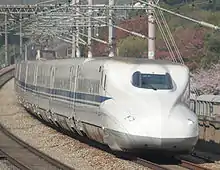 JR West N700 series, April 2009
JR West N700 series, April 2009
Former rolling stock
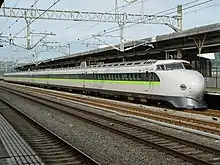 0 series Kodama in July 2003
0 series Kodama in July 2003 JR West 100 Series on a Sanyō Shinkansen Kodama service in October 2008
JR West 100 Series on a Sanyō Shinkansen Kodama service in October 2008 JR West 300 series on 8 October 2008
JR West 300 series on 8 October 2008 JR Central 700 series, April 2009
JR Central 700 series, April 2009
Pre-shinkansen
- 151 series
Formations
N700 series (16 cars)
(All cars are no smoking except for smoking compartments located in cars 3, 7, 10, and 15.)
| ←Hakata | Tokyo→ | ||||||||||||||
| 1 | 2 | 3 | 4 | 5 | 6 | 7 | 8 | 9 | 10 | 11 | 12 | 13 | 14 | 15 | 16 |
|---|---|---|---|---|---|---|---|---|---|---|---|---|---|---|---|
| NR | NR | NR | NR | NR | NR | NR | G | G | G | R | R | NR | NR | NR | R |
500 series (eight cars)
(All cars are no smoking except for smoking compartments in cars 3 and 7.)
| ←Hakata | Shin-Osaka→ | ||||||
| 1 | 2 | 3 | 4 | 5 | 6 | 7 | 8 |
|---|---|---|---|---|---|---|---|
| NR | NR | NR | NR | NR | R | NR | NR |
N700 series (eight cars)
(All cars are no smoking except for smoking compartments in cars 3 and 7.)
| ←Hakata | Shin-Osaka→ | |||||||
| 1 | 2 | 3 | 4 | 5 | 6 | 7 | 8 | |
|---|---|---|---|---|---|---|---|---|
| NR | NR | NR | NR | R | R | G | NR | NR |
700 series (eight cars)
(All cars are non-smoking.)
| ←Hakata | Shin-Osaka→ | ||||||
| 1 | 2 | 3 | 4 | 5 | 6 | 7 | 8 |
|---|---|---|---|---|---|---|---|
| NR | NR | NR | NR | NR | NR | NR | C |
- G: Green car (first class) (reserved seating)
- R: Standard class reserved seating
- C: Standard class reserved seating + compartments
- NR: Standard class non-reserved seating
- NS: Non-smoking seats
- S: Smoking seats
History
Limited express Kodama
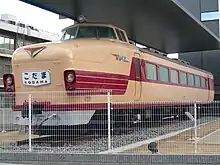
Kodama debuted as a limited express service on the Tokaido Main Line on 1 November 1958. Services used 151 series trainsets. This was the first EMU train service of the Japanese National Railways classified as a limited express, the highest (fastest) of train types on the national railway system. The train travelled between Tokyo Station and Osaka Station in six hours and 50 minutes and first enabled passengers to go and return between the two cities in one day. This is why the train was named Kodama, or echo.
A narrow gauge world speed record of 163 km/h was established by a 151 series Kodama trainset on 31 July 1959.[3] The conventional Kodama train ran until 30 September 1964, the day before Kodama debuted on the Shinkansen.
Shinkansen Kodama
The shinkansen Kodama services began on 1 October 1964, operating between Tokyo and Shin-Osaka.
On 17 March 2012, the remaining 100 series (K) sets were withdrawn from Kodama services and 700 series (8-car E set) Kodama services became entirely no-smoking.[4] Onboard trolley refreshment services were discontinued on all JR Central Kodama services from 17 March 2012.[5] Also, some of the 16-car 500 series that used to run as the Nozomi service were cut short to eight cars to run as the Kodama service.
Future plans
In an announcement by JR Central, JR West, and JR Kyushu made on 17 October 2023, the companies stated that all onboard smoking rooms on the Tokaido, San'yo, and Kyushu Shinkansen trains would be abolished by Q2 2024.[6]
See also
References
- ↑ JR新幹線&特急列車ファイル [JR Shinkansen & Limited Express Train File]. Japan: Kōtsū Shimbun. 2008. ISBN 978-4-330-00608-6.
- ↑ "About JAPAN RAIL PASS | JAPAN RAIL PASS". japanrailpass.net. Retrieved 12 September 2023.
- ↑ "- YouTube". YouTube.
- ↑ 平成24春ダイヤ改正について [March 2012 Timetable Revision Details] (PDF). News Release (in Japanese). Japan: West Japan Railway Company. 16 December 2011. Archived from the original (PDF) on 16 December 2011. Retrieved 17 December 2011.
- ↑ 一部列車の車内販売の取止め及び見直しについて [Discontinuation and revision of on-train sales for certain trains] (PDF). News Release (in Japanese). Japan: Central Japan Railway Company. 2012. Retrieved 11 March 2012.
- ↑ Kinoshita, Kenji (17 October 2023). "東海道・山陽・九州新幹線の車内喫煙ルーム、2024年春にすべて廃止" [All smoking rooms on Tokaido, Sanyo, and Kyushu Shinkansen trains will be abolished in spring 2024.]. MyNavi Corporation. Archived from the original on 18 October 2023. Retrieved 19 October 2023.

